Click On Image
For Full Size Image |
Size |
Image Description |
Contributed
By |
Namesake
|
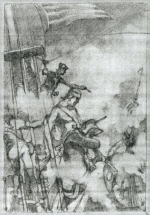
0540632 |
60k |
Edward Stack, also known as Edward Stack de Crotto, was born in Kealid (Kelad, Gaelic Caolaid), Knockanure, Kerry, Ireland, on 28 April 1756. The Stack family was a long-established one in Ireland with historical connections to France. The "de Crotto" stems from their family seat in Crotta, which was seized by Cromwell. Staunch Catholics, many Stacks went to France to serve its Catholic kings.
Educated at the Collège des Irlandais in Paris, Stack was commissioned a second lieutenant in Walsh's Regiment of the Irish Brigade on 23 March 1777, and is said to have accompanied Marquis de Lafayette's expedition to Virginia the next year. On 05 February 1779 his service was recommended by Captain Fitz-Maurice of Walsh's Regiment to John Paul Jones, who needed men to fit out Bon Homme Richard. On 01 May 1779, Jones wrote to Benjamin Franklin: "I take the liberty to inclose the Memoire of a young gentleman who has waited here a long time of his own accord to Embark with me as I have a Particular regard for his character if you think fit to Send his paper to Court I Should be glad to have him with me- I Can find no person so proper to Disciplin the Voluntier Soldiers that I have inlisted." Stack was breveted a Lieutenant in the Marine Corps.
Stack commanded the fifteen marines and four seamen in the main top of Bon Homme Richard during her battle with HMS Serapis on 23 September 1779. Fire superiority aloft enabled the Americans to drive the British from their tops and harass them on deck. A grenade thrown from the tops fired a chain of ammunition on Serapis, causing a severe explosion which was a principal factor in her surrender. In his report of the action, Jones commended Stack for his great bravery. After the battle, the battered Serapis put into Texel, Holland. Here on 01 October some 26 deserters attempted an escape, pursued by a party led by Stack. Sixteen were recaptured, five drowned, and five escaped. It is perhaps fitting to note here that the motto of the Irish Brigade was Semper et Ubique Fidelis, meaning "Always and everywhere Faithful," which almost certainly inspired the US Marine Corps' famous motto Semper Fidelis.
On 25 November 1779, Stack was released from duty with Jones, his regiment receiving orders to embark for the Antilles. He received an award from Louis XVI of 440 livres and a commission as captain, where he served as such with the 2nd Battalion in the West Indies until 1783. He later served in Walsh's regiment (renamed 92e Regiment in 1791) on the Rhine and at Coblenz, and as an aide-de-camp to King Louis XVI. On 30 January 1791 Stack was invested as a Chevalier de St.Louis, a knight of the French realm. On 25 July of that year, he was promoted to Lt. Colonel of the 87e Regiment (formerly Dillon's regiment). While garrisoned at Bergues that October, and disillusioned by being passed over for command of the 88e Regiment, Stack and eight other officers left France for England, following the pattern of sixty percent of the French Army officer corps in the upheaval caused by events leading up to the French Revolution. In 1793-1794 he served with the Legion de Damas, formed by William of Orange from emigres on Dutch territory.
Appointed to Walsh-Serrant's Regiment of England's Irish Brigade on 01 October 1794, Stack served in Ireland until being embarked with his regiment for the West Indies in May 1796. Arriving in Jamaica in August, he and his men were in garrison due to a typhus outbreak until early 1797. the tedium of garrison duty and illness took its toll, as evidenced when Stack killed his second-in-command, Major William O'Shee, in a duel on 19 September. In September 1797 the regiment, decimated by disease, returned to England on transport Catherine. On 01 March 1798, the Irish Brigade was disbanded and Stack placed on half-pay. On 01 January 1801 he was promoted to Lt. Colonel in the British Army, and on 18 April given command of the North Lowland Fencibles.
Though appointed Brigadier General on 01 September 1803, Stack was still on half-pay. With the Treaty of Amiens in 1802 he returned to France, apparently to dispose of estates he held there. With the outbreak of war once again in May 1803, Stack was arrested as an alien subject to British Army service at Verdun and placed under house arrest. Later spending three years in captivity at Citadelle de Bitche, he was sentenced to be executed with the unfortunate duc d'Enghien, falsely accused of conspiring for the British, in 1804. However, Napoleon cancelled the order at the last moment. While in captivity, Stack was promoted to Major General 31 May 1808 and Lt. General 04 June 1813, finally being released at the end of the conflict in 1814. On 22 July 1803 he was promoted to full General, and died at Hotel Roberts in Calais on 02 December 1833.
"Edward Stack's Marines firing from the rigging of John Paul Jones' Bon Homme Richard down on the English sailors of the Serapis," ink drawing by Arman Manookian, circa 1920s. Honolulu Academy of Arts, via Wikimedia Commons.
| Dave Wright |
USS Stack (DD-406)
|

| 52k | Undated, New York Harbor. | Alan Stachowitz |

| 184k | Christening of USS Rowan (DD-405) and USS Stack (DD-406) at Norfolk Navy Yard, 05 May 1938. | Ron Reeves |

| 38k | Off the Norfolk Navy Yard, circa late 1939-40. Note snow on the ship's after gun mount covers. | Marc Piché/Robert Hurst/Joe Radigan |

| 117k | USS Stack (DD-406), circa 1940, location unknown. Image from the 1943-44 edition of Jane's Fighting Ships. | Robert Hurst |

| 94k | USS Stack (DD-406) coming into Hvalfjord, Iceland from North Atlantic Patrol, 27 January - 01 February 1942. USS Tuscaloosa (CA-37) is anchored in the background.
Imperial War Museum Admiralty Official Collection by Parnall, C.H. (Lt), photo A 7488 | Robert Hurst/Mike Green |

| 42k | Port broadside photo of the USS Stack (DD-406) on 06 August 1942. Photo from the 1943-45 Naval Recognition Manual. | Mike Green |

0540633 |
112k | On 06 August 1942, PBY-5 11-P-13 (BuNo 2410), based on McFarland (AVD-14) at Ndeni in the Santa Cruz Islands, took off on a routine patrol. The aircraft ran out of gas and landed near Indispensable Reef, approximately 80 miles southwest of Ndeni. Three days later (09 August), Stack was part of Task Force 18, retiring south from the first Guadalcanal landings. She drew the task of locating the disabled PBY. Her relentless skipper criss-crossed a wide area of open ocean for nearly sixteen hours, refusing to give up rescuing the crew of the lost plane. Finally at 1507 10 August, Stack made contact with the drifting plane. Hoping to salvage the PBY and tow it back to base, the plane's crew signaled it could not stay afloat more than a few hours without someone remaining aboard to bail it out. Deeming that too dangerous, Stack's whaleboats instead recovered the ten man crew and classified documents, and at 1605 the destroyer fired four 5" rounds, setting the plane afire. At 1625 the PBY was seen to sink, and Stack left the area to rejoin TF 18. The next day she transferred the VP-11 crew to Platte (AO-24), ending an interesting sidelight of the Pacific War.
National Archives photo 80-G-16762 | Rick Davis & John Chiquoine |

0540629 |
679k | View taken at Mare Island, California, Navy Yard, 19 March 1943, plan view, aft. Alterations are indicated by circles. Note YF-462 at other side of pier, and dredge in channel (background)
National Archives photo 19-N-42255 | Dave Wright |
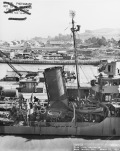
| 442k | USS Stack (DD-406) plan view amidships, from the pilothouse to the torpedo tubes, taken at the Mare Island Navy Yard, California, 19 March 1943. Note details of the ship's foremast and smokestack; barge YF-462 and ammunition depot in the background.
National Archives photo 19-N-42253 | Fred Weiss |

| 599k | USS Stack (DD-406) Plan view forward, from the bow to the pilothouse, taken at the Mare Island Navy Yard, California, 19 March 1943. Note details of the ship's bridge and Mark 33 gun director. Also note open passenger tractor-trailer rig at right and supply storage area in the distance.
National Archives photo 19-N-42254 | Fred Weiss |

| 405k | USS Stack (DD-406) underway off Mare Island Navy Yard, California, 21 March 1943.
National Archives photo 19-N-42249 | Fred Weiss |

| 421k | USS Stack (DD-406) underway off Mare Island Navy Yard, California, 21 March 1943.
National Archives 19-N-42250 | Fred Weiss |

0540630 |
679k | Bow view of USS Stack (DD-406) underway off Mare Island, California, Navy Yard, 21 March 1943.
National Archives photo 19-N-42251 | Dave Wright |

| 89k | Stern view of USS Stack (DD 406) off Mare Island on 21 March 1943.
Navy Photo 1875-3-43 | Darryl Baker |

| 86k | Broadside view of USS Stack (DD 406) off Mare Island on 21 March 1943. She was in overhaul at the yard, 02 February - 21 March 1943.
Navy Photo 1877-3-43 | Darryl Baker |

| 38k | Photo from Our Navy magazine, April 1943. | Chet Morris |
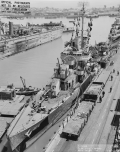
| 718k | USS Stack (DD-406) Plan view forward, taken at the Mare Island Navy Yard, California, 05 May 1944. Note long dent in her hull side, near the waterline somewhat aft of her hull number; Mark 33 gun director atop the pilothouse; and 5"/38 guns. Also note USS Farenholt (DD-491) tied up astern; floating drydock ARD-11 with USS Lamson (DD-367) in the dock at left, diver boat just off Stack's starboard side and railway cars on the pier. Circles mark recent alterations to the ship.
National Archives photo 19-N-67029 | Fred Weiss / Darryl Baker |
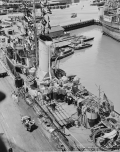
| 815k | View amidships, taken at the Mare Island Navy Yard, 05 May 1944. ARD-11 is visible at upper right.
National Archives 19-N-67030 | Dave Wright |
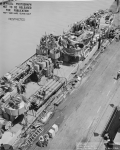
| 730k | USS Stack (DD-406) Plan view aft, taken at the Mare Island Navy Yard, California, 05 May 1944. Note quadruple torpedo tubes on the main deck, and secondary conning station between the 40mm gun mounts on the after deckhouse.
National Archives photo 19-N-67031 | Fred Weiss |

| 292k | USS Stack (DD-406) off the Mare Island Navy Yard, California, 27 May 1944. Her camouflage is Measure 31, Design 11d.
National Archives photo 19-N-67023 | Fred Weiss |

| 287k | USS Stack (DD-406) off the Mare Island Navy Yard, California, 27 May 1944. Her camouflage is Measure 31, Design 11d.
National Archives photo 19-N-67024 | Fred Weiss |

| 304k | USS Stack (DD-406) off the Mare Island Navy Yard, California, 27 May 1944. Her camouflage is Measure 31, Design 11d.
National Archives photo 19-N-67025 | Fred Weiss |

0540631 |
328k | USS Stack (DD-406) off the Mare Island Navy Yard, California, 27 May 1944. Her camouflage is Measure 31, Design 11d.
National Archives photo 19-N-67026 | Fred Weiss |

| 95k | Stern view of USS Stack (DD 406) off Mare Island on 27 May 1944. She was in overhaul at the shipyard from 22 March until 27 May 1944.
Navy Photo 3200-44 | Darryl Baker |

| 333k | Bow on view of USS Stack (DD 406) off Mare Island on 27 May 1944. She was in overhaul at the shipyard from 22 March until 27 May 1944. Note ship's whale boat is rigged outboard.
National Archives photo 19-N-67027 | Darryl Baker |

| 116k | Scene on 11 October 1944 in Humboldt Bay, New Guinea, while amphibious support units were making final preparations to depart for the Leyte invasion. In the center distance is Stack (DD-406), and in the near center is Teak (AN-35).
National Archives photo 80-G-257931 | John Chiquoine and Dave Schroeder |

| 243k | Stack in 1945 as they were moving wounded off of an aircraft carrier. From the collection of former crewmember Ray Benoit. | Ray Benoit |

| 110k | USS Stack (DD-406) View of the ship's forward portion, probably taken soon after she had been used as a target during the July 1946 Operation "Crossroads" atomic bomb tests. Note test structure on her bow and the apparently scorched condition of her paint.
Naval History & Heritage Command photo NH 97967 | Fred Weiss |

